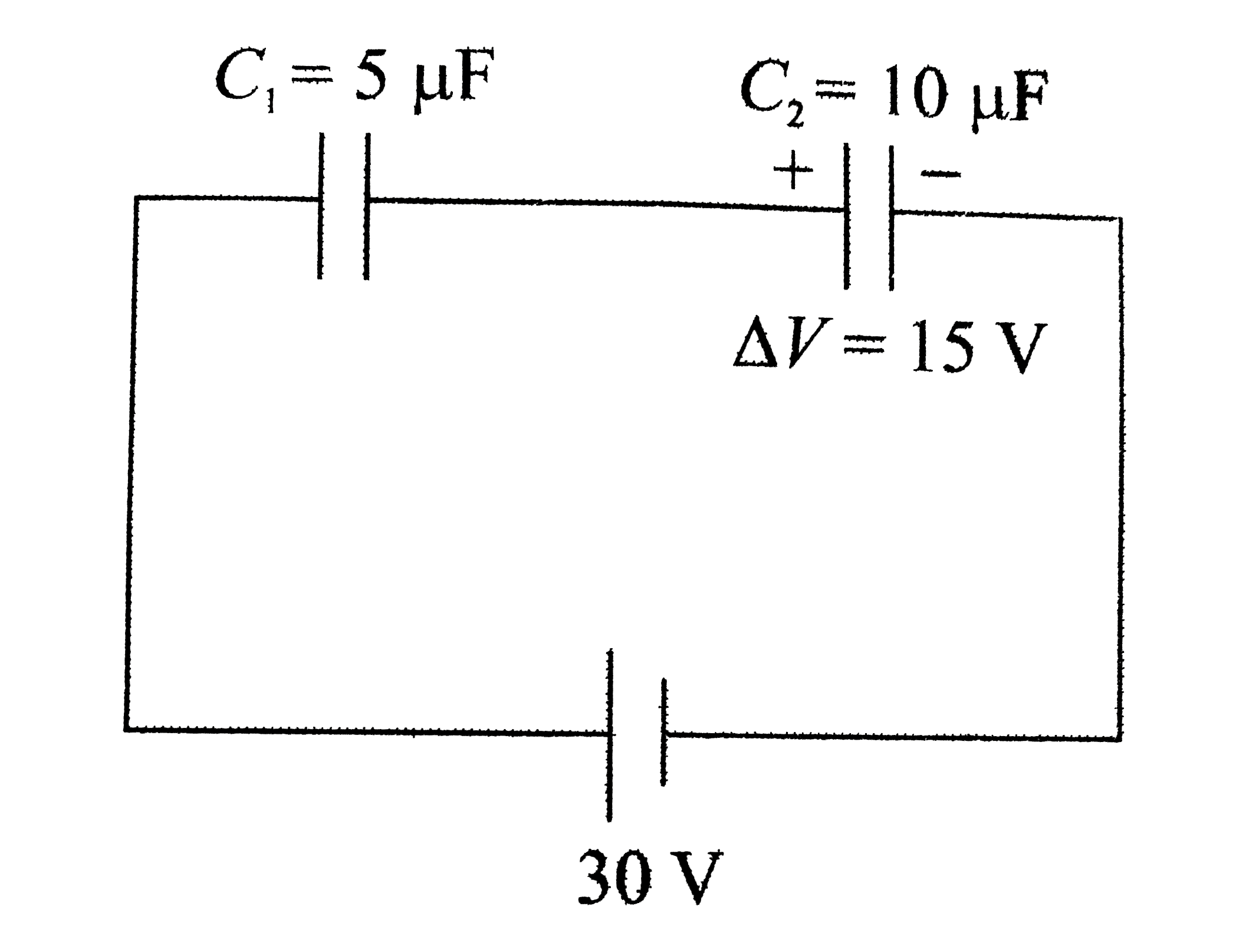A 20F capacitor is charged to 5V and isolated. It is then connected in parallel with an uncharged 30F capacitor. The decrease in the energy of the system will be
25J
200J
125J
150J
The correct Answer is:D
Charge stored on 20F capacitor =20×5=100C
When 20F capacitor is connected to 30F capacitor,
V=qC1+C2=10020+30=2V
Energy of the system will be Ef=12×(30+20)×(2)2
=100J
Energy before isolation Ei=12×20×(5)2=250J
Therefore, decrease in energy =250−100=150J
Topper's Solved these Questions
- BOOK - A2ZCHAPTER - ELECTRIC POTENTIAL & CAPACITANCEEXERCISE - Capacitor Circuits52videos
ELECTRIC POTENTIAL & CAPACITANCE
- BOOK - A2ZCHAPTER - ELECTRIC POTENTIAL & CAPACITANCEEXERCISE - Problems Based On Mixed Concepts44videos
ELECTRIC POTENTIAL & CAPACITANCE
- BOOK - A2ZCHAPTER - ELECTRIC POTENTIAL & CAPACITANCEEXERCISE - Capacitor With Dielectric32videos
ELECTRIC POTENTIAL & CAPACITANCE
- BOOK - A2ZCHAPTER - ELECTRIC CHARGE, FIELD & FLUXEXERCISE - Section D - Chapter End Test29videos
ELECTRIC CHARGE, FIELD & FLUX
- BOOK - A2ZCHAPTER - ELECTROMAGNETIC INDUCTIONEXERCISE - Section D - Chapter End Test30videos
ELECTROMAGNETIC INDUCTION
Similar Questions
A10μF capacitor is charged to 200 V and is isolated. It is then connected to another 10μF uncharged capacitor. The total electrostatic energy of the capacitor remains conserved.
View SolutionA 10μF capacitor is charged to 15V. It is next connected in seties with an uncharged 5μf capacitor. The series cambination is finally connected across a 30V battery, as shown in. Find the new potential differnce across the 5μF and 10μF capacitors.
 View Solution
View Solution
Knowledge Check
- Question 1 - Select One
An air capacitor is charged upto a potential V1. It is connected in parallel to an identical uncharged capacitor filled with a dielectric medium. After redistribution of charge if the potential difference of this combination is V, then the dielectric constant of the substance will be
AV2(V1−V)BV(V1−V)CV(V1−V)D(V1−V)V - Question 2 - Select One
A capacitor or capacitance C1 is charge to a potential V and then connected in parallel to an uncharged capacitor of capacitance C2. The fianl potential difference across each capacitor will be
AC1VC1+C2BC2VC1+C2C1+C2C1D1−C2C1 - Question 3 - Select One
A capacitor or capacitance C1 is charge to a potential V and then connected in parallel to an uncharged capacitor of capacitance C2. The fianl potential difference across each capacitor will be
AC1VC1+C2BC2VC1+C2C1+C2C1D1−C2C1
A parallel plate capacitor of capacitance C is charged to a potential V. It is then connected to another uncharged capacitor having the same capacitance. Find out the ratio of the energy stored in the combined system to that stored initially in the single capacitor.
View SolutionA parallel plate capacitor of capacitance C is charged to a potential V. It is then connected to another uncharged capacitor having the same capacitance. Find out the ratio of the electrostatic energy stored in the combined system to that stored initially in the single capacitor.
View Solution[" Chemistry "],[" The potential difference across a "2 mu F" capacitor is "18V],[" when it is not connected to anything.It is then connected in "],[" parallel with an uncharged "4 mu F" capacitor.In equilibrium the "],[" charge "q" on the "2 mu F" capacitor and the potential difference "],[V/" across it,then "]
View Solution[" Chemistry "],[" The potential difference across a "2 mu F" capacitor is "18V],[" when it is not connected to anything.It is then connected in "],[" parallel with an uncharged "4 mu F" capacitor.In equilibrium the "],[" charge "q" on the "2 mu F" capacitor and the potential difference "],[V/" across it,then "]
View SolutionA capacitor of capacity C charged to potential "V" and " then connected to an identical uncharged capacitor then loss of energy is
View Solution

